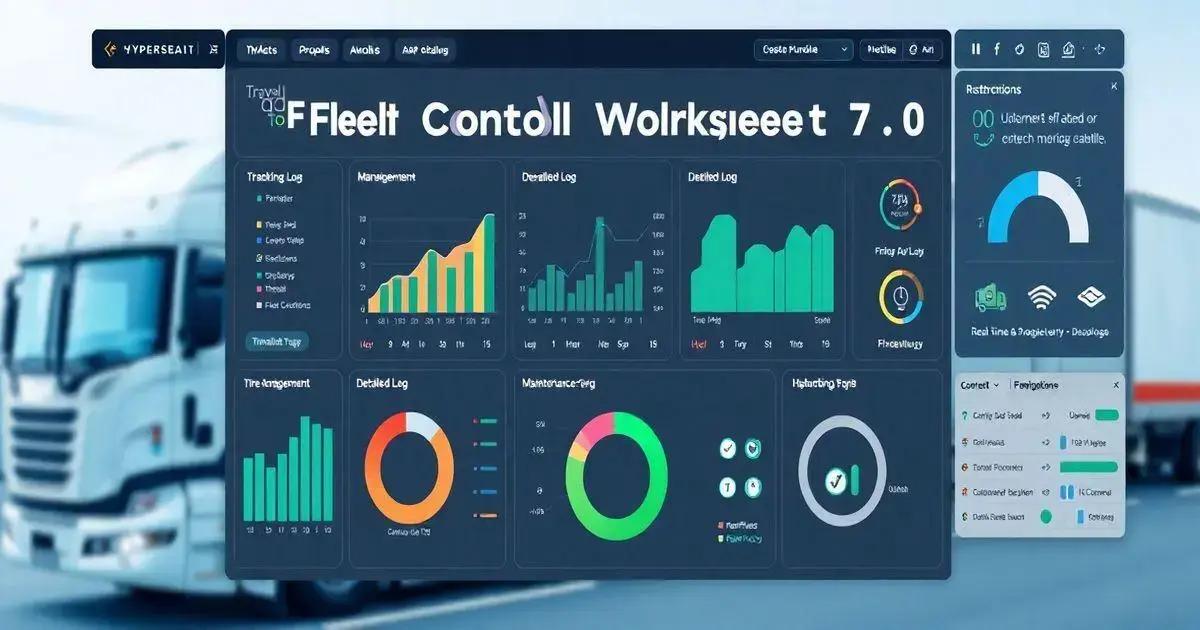Top 5 Features of Fleet Control Worksheet 7.0 Leave a comment
The Fleet Control Worksheet 7.0 is an advanced fleet management tool that offers features like an Initial Dashboard for tracking key metrics (kilometers driven, fuel efficiency, maintenance costs), Travel Control for cargo and driver management, Tire Control Management for monitoring tire usage and maintenance, Maintenance Tracking for detailed records of vehicle upkeep, and a Document Management System for organizing essential documentation and alerts. This comprehensive solution helps fleet managers optimize performance, enhance safety, and ensure compliance.
The Fleet Control Worksheet 7.0 is designed to optimize fleet management with essential tools for tracking and reporting.
This updated version includes an initial dashboard, detailed travel and cargo control logs, tire management, and maintenance tracking.
In this post, we’ll explore the top five features that make this worksheet indispensable for any fleet manager.
Initial Dashboards Overview
The Initial Dashboards of the Fleet Control Worksheet 7.0 provide a comprehensive overview of key metrics essential for effective fleet management. With these dashboards, users can quickly assess performance and make data-driven decisions.
Key Metrics Displayed:
- KM by Driver: Track the total kilometers driven by each driver, enabling you to identify performance trends and optimize routes.
- KM per Vehicle: Monitor the distance covered by each vehicle to ensure that all units are operating efficiently.
- KM per Liter: Analyze fuel efficiency across your fleet, helping you identify vehicles that may require maintenance or replacement.
- KM per Trip: Evaluate the average distance driven per trip to optimize scheduling and reduce costs.
- Average Consumption per Vehicle: Keep tabs on fuel consumption for each vehicle, which can lead to better fuel management strategies.
- Average Consumption per Driver: Assess the fuel efficiency at the driver level to provide training or adjustments where necessary.
- Total General Maintenance: Includes both preventive and corrective maintenance totals to track overall fleet health.
- Maintenance Cost Average: Calculate the average cost of maintenance per vehicle, aiding in budget forecasting.
- Total Mechanical and Electrical Maintenance Costs: A snapshot of all maintenance expenses to ensure financial health and transparency.
- Total Tire Maintenance Cost: Monitoring tire expenses helps in tire management and budgeting for replacements.
- Total Lubricant Cost: Keep track of lubricant expenditures to manage operational costs better.
- Vehicles in Transit: Know how many vehicles are currently on the road for better logistics planning.
- Tires in Transit: Track tire inventory during transit to manage supply effectively.
- Delayed Vehicle Documents: Stay aware of any documentation delays that could affect compliance.
- Delayed Driver Documents: Monitor the status of driver documents to ensure operational compliance.
- Delayed Preventive Maintenance: Identify any overdue maintenance tasks to ensure vehicle safety and compliance.
- Total Cost Versus Shipping: Compare total operational costs against revenue from shipping to assess profitability.
- Fuel, Maintenance, and Other Costs: A consolidated view of all costs related to the fleet to aid in comprehensive financial planning.
This feature-rich dashboard makes it easier for fleet managers to visualize crucial data, ensuring they can react swiftly to any issues that arise. Regularly reviewing these metrics can lead to improved efficiency and cost savings, fostering a more effective fleet management strategy.

Travel Control Features
The Travel Control Features in the Fleet Control Worksheet 7.0 are designed to streamline the tracking and management of all travel-related activities. This functionality is essential for maintaining efficiency and ensuring that all aspects of fleet operations are accounted for.
Key Components of Travel Control:
- Cargo Control Linked to Trips: This feature allows fleet managers to link cargo details directly to specific trips. It ensures that every cargo load is tracked from start to finish, minimizing the risk of loss and improving accountability.
- Vehicle Control: Monitor which vehicles are used for each trip, helping to ensure that the right vehicles are dispatched for the right jobs based on availability and capability.
- Driver Control: Keep track of which driver is assigned to each trip. This helps manage driver schedules and ensures that drivers are not overworked, which can lead to better safety and performance.
- Supply Control: Manage all supplies associated with each trip, including fuel, food, and other necessities. This feature helps ensure that drivers have everything they need for their journeys, reducing the chance of delays.
- Control of All Travel Expenses: Documenting all expenses related to travel, including fuel, tolls, meals, and lodging, is critical for comprehensive financial management. This feature allows for easy tracking and reporting, enabling better budget control.
By incorporating these travel control features, the Fleet Control Worksheet 7.0 not only enhances operational efficiency but also ensures that all travel activities are meticulously documented and managed. This leads to better resource allocation, reduced costs, and improved overall fleet performance.
Tire Control Management
The Tire Control Management feature in the Fleet Control Worksheet 7.0 is crucial for maintaining the safety and efficiency of your fleet. Proper tire management not only extends the lifespan of tires but also enhances vehicle performance and reduces overall costs.
Essential Elements of Tire Control Management:
Essential Elements of Tire Control Management:
- Identification for Each Tire: Each tire can be assigned a unique identification number, allowing for easy tracking and management throughout its life cycle. This ensures that you know the history and usage of every tire in your fleet.
- Tire Change Schedule by KM: The worksheet includes a predefined schedule for tire changes based on the kilometers driven. This proactive approach helps prevent tire-related issues and ensures that tires are replaced before they become dangerous.
- Signal of How Much KM is Left to Change the Tire: This feature provides a clear indication of how many kilometers remain before a tire must be replaced, allowing managers to plan changes effectively and avoid unforeseen breakdowns.
- Status per Action: Track the status of each tire based on actions taken: allocate to vehicle, remove from vehicle, scrap, or maintenance. This helps in maintaining an organized tire inventory and facilitates quick decision-making.
These components work together to create a robust tire management system that enhances safety and efficiency. By regularly monitoring tire conditions and adhering to the maintenance schedule, fleet managers can significantly reduce downtime and extend the life of their tires.
![]()
Maintenance Tracking Capabilities
The Maintenance Tracking Capabilities of the Fleet Control Worksheet 7.0 are designed to ensure that all vehicles within the fleet are kept in optimal condition. Regular maintenance is crucial for safety, efficiency, and longevity of the vehicles, and this feature aids in managing all maintenance activities effectively.
Key Components of Maintenance Tracking:
Key Components of Maintenance Tracking:
- Corrective and Preventive Maintenance Types: The worksheet categorizes maintenance tasks into corrective and preventive types, allowing fleet managers to differentiate between routine checks and repairs needed due to issues. This helps prioritize maintenance activities accordingly.
- Maintenance by Vehicle: Track maintenance records for each individual vehicle in the fleet. This feature ensures that managers can easily access the history of maintenance performed, including dates, types of services, and costs associated with each vehicle.
- Maintenance by Mechanical and Electrical Type, Tire and Lubricants: Differentiate maintenance tasks based on their nature—mechanical, electrical, tire-related, or lubricant services. This specificity allows for more targeted management and resource allocation.
- Maintenance Cost: Keep a running total of all maintenance expenses incurred by each vehicle. By monitoring these costs, fleet managers can identify trends and potential areas for savings, ultimately helping in budget management.
- Preventive Maintenance Schedule: The worksheet provides a schedule for preventive maintenance tasks based on mileage and usage. This proactive approach helps avoid unexpected breakdowns and extends the life of the vehicles.
- Preventive Maintenance Signal: Alerts fleet managers when preventive maintenance is due, ensuring that tasks are not overlooked. Timely reminders facilitate better planning and ensure compliance with maintenance schedules.
- Status by Scheduled, Accomplished, and Delayed: Monitor the status of maintenance tasks to quickly identify which ones are scheduled, completed, or overdue. This visibility enables effective management of maintenance workloads and helps ensure compliance with safety regulations.
With these maintenance tracking capabilities, the Fleet Control Worksheet 7.0 allows fleet managers to maintain a high level of vehicle performance and safety. Regular and systematic maintenance can lead to reduced operational costs, minimized downtime, and enhanced fleet reliability.
Document Management System
The Document Management System within the Fleet Control Worksheet 7.0 is essential for maintaining proper records related to both drivers and vehicles. Efficient document management is critical for compliance, safety, and seamless operation within a fleet.
Core Features of the Document Management System:
Core Features of the Document Management System:
- Driver Document Control: This feature allows fleet managers to manage and track all necessary documentation for each driver, including licenses, certifications, and training records. Keeping these documents organized ensures that all drivers are compliant with regulations and fully qualified to operate vehicles.
- Vehicle Document Control: Similar to driver documents, this feature enables the management of all vehicle-related documents, such as registration, insurance, maintenance records, and inspection certificates. This organization is crucial for ensuring that vehicles are legally compliant and safe to operate.
- Alerts for Expiring Documents: The system provides alerts for any approaching expiration dates on critical documents, such as driver licenses or vehicle registrations. This proactive approach helps prevent lapses in compliance and ensures timely renewals.
- Storage of Document Copies: Users can store digital copies of essential documents right within the worksheet. This centralized storage makes it easy to access important information quickly, avoiding the hassle of sifting through physical paperwork.
- Document Accessibility and Sharing: The document management system allows for easy sharing of documents among relevant team members. Whether it’s a compliance officer or a fleet manager, everyone can have access to the necessary documentation to perform their roles efficiently.
By utilizing this comprehensive Document Management System, the Fleet Control Worksheet 7.0 helps streamline operations, improve compliance, and enhance overall fleet management. Proper document control not only protects the fleet’s legal standing but also promotes a culture of safety and accountability among drivers and operations staff.
Conclusion
The Fleet Control Worksheet 7.0 equips fleet managers with a robust set of tools to effectively oversee their operations.
With features like travel control, tire management, maintenance tracking, and document management, this worksheet addresses the essential needs of modern fleet management.
By leveraging these capabilities, organizations can enhance efficiency, reduce operational costs, maintain compliance, and improve the overall safety of their fleets.
Regularly utilizing the analytics and tracking functions provided by the worksheet ensures that fleet managers stay informed and proactive in their decision-making.
In a world where efficient fleet management is crucial for success, the Fleet Control Worksheet 7.0 stands out as an invaluable resource for any organization looking to optimize their fleet operations.
FAQ – Frequently Asked Questions about Fleet Control Worksheet 7.0
What features are included in the Fleet Control Worksheet 7.0?
The Fleet Control Worksheet 7.0 includes travel control, tire management, maintenance tracking, document management, and initial dashboards for performance metrics.
How can I track tire management effectively?
Tire management can be tracked using the identification system for each tire, tire change schedules, and monitoring of tire statuses and costs.
What types of maintenance can be tracked with this worksheet?
You can track both corrective and preventive maintenance, along with detailed records for each vehicle’s maintenance history.
How does the document management system help in fleet management?
The document management system helps keep track of all driver and vehicle documentation, ensuring compliance and easy access to important records.
Are alerts provided for expiring documents?
Yes, the system provides alerts for any approaching expiration dates on critical documents, allowing you to manage renewals proactively.
Is the Fleet Control Worksheet customizable for my specific needs?
Yes, the worksheet can be customized to fit the specific requirements of your fleet and operational processes.

